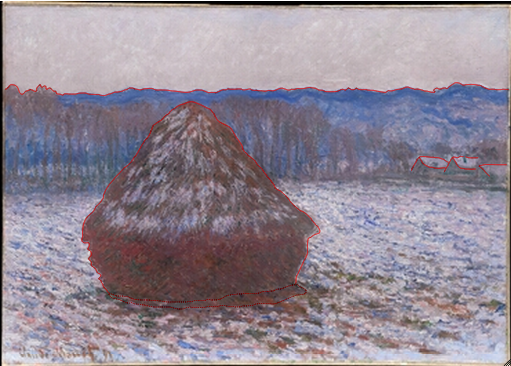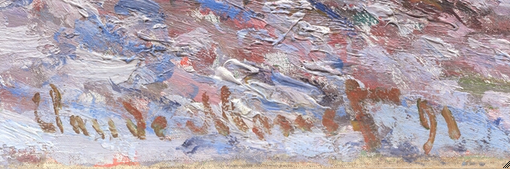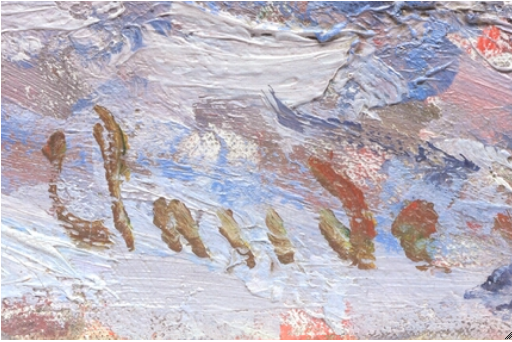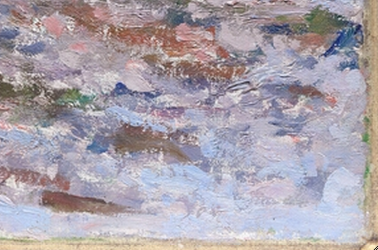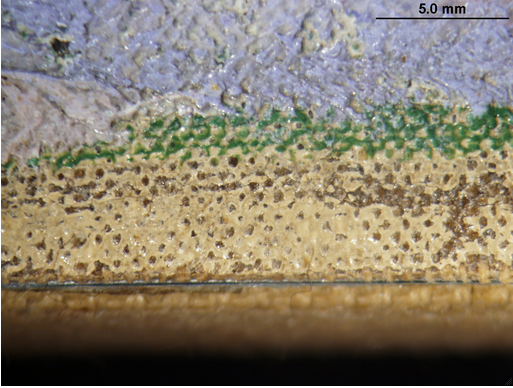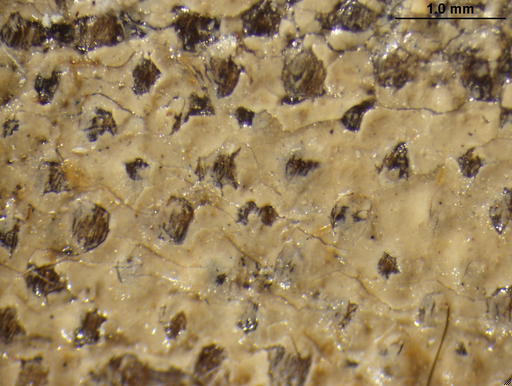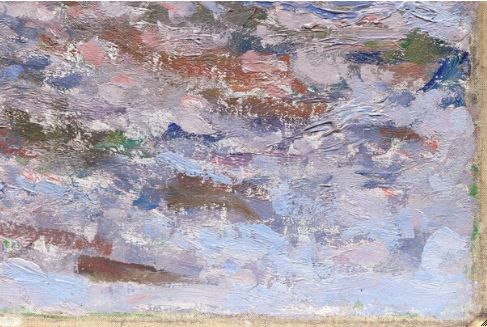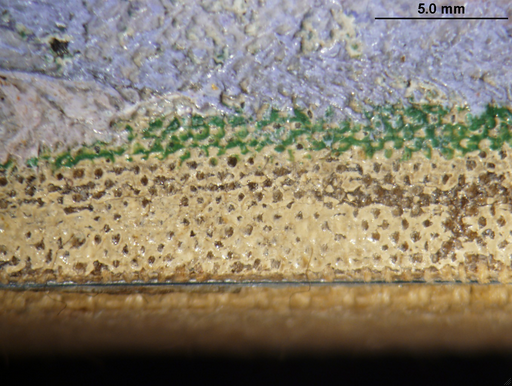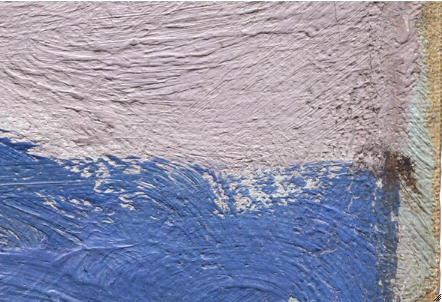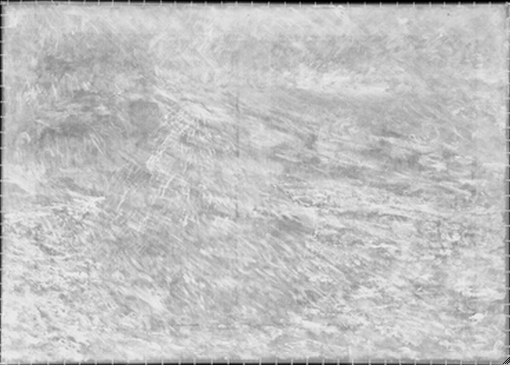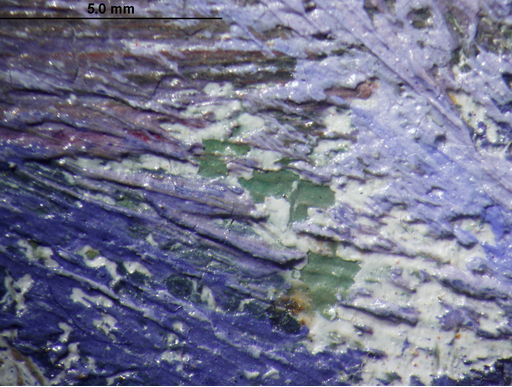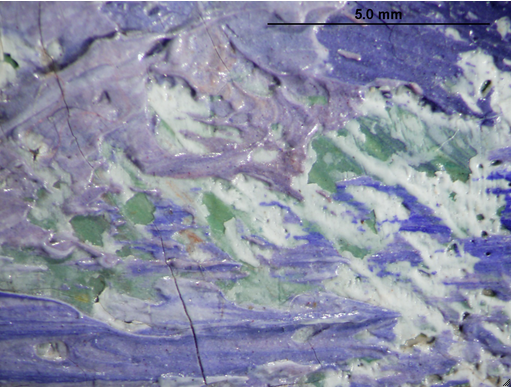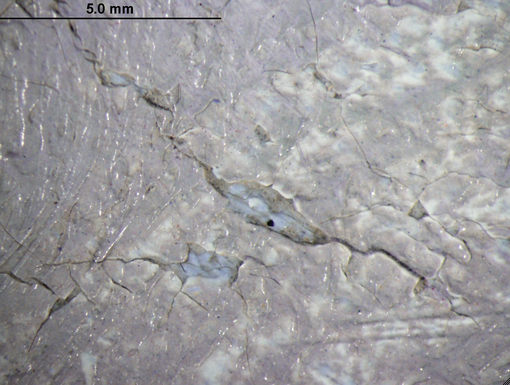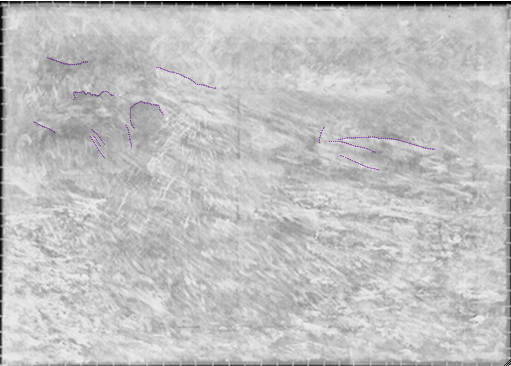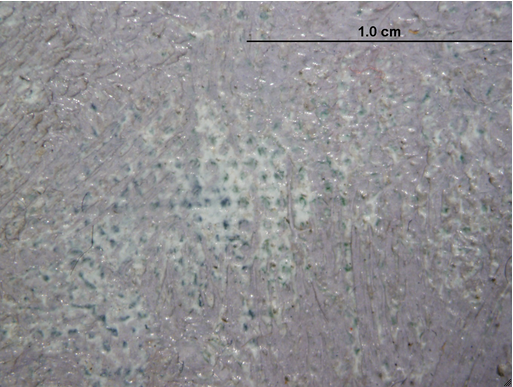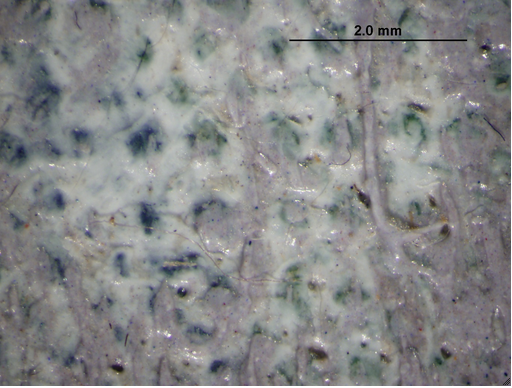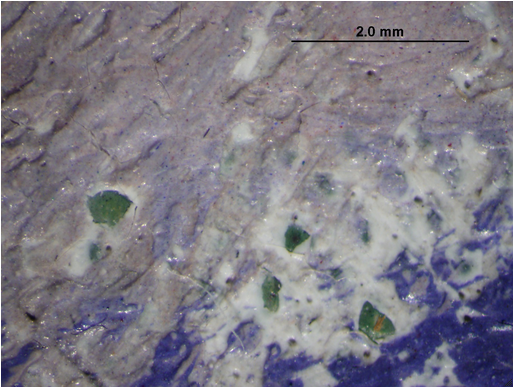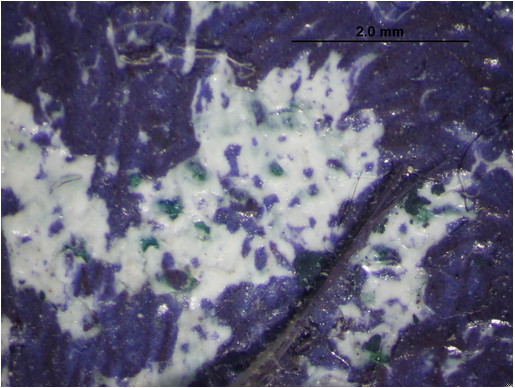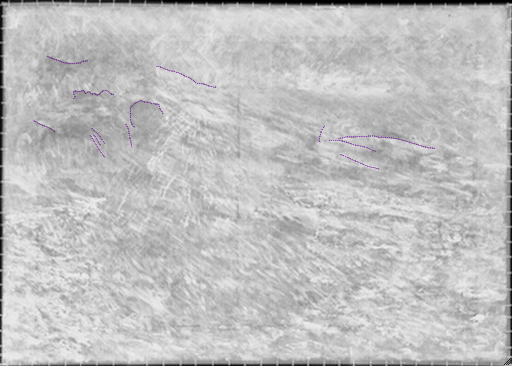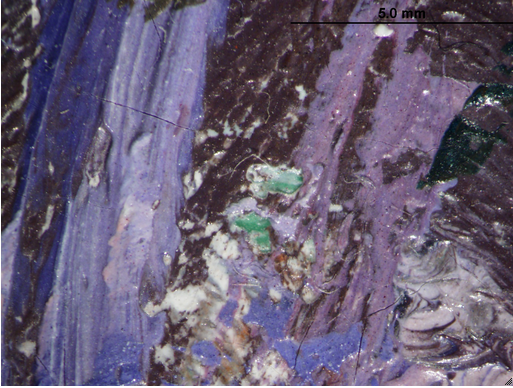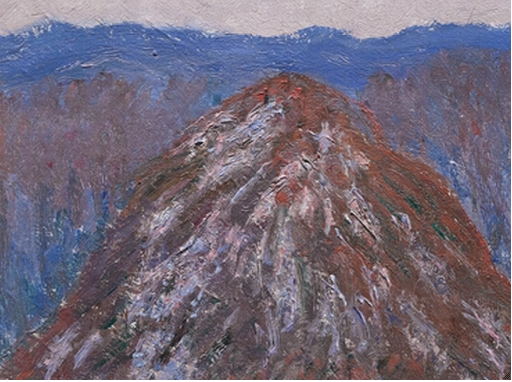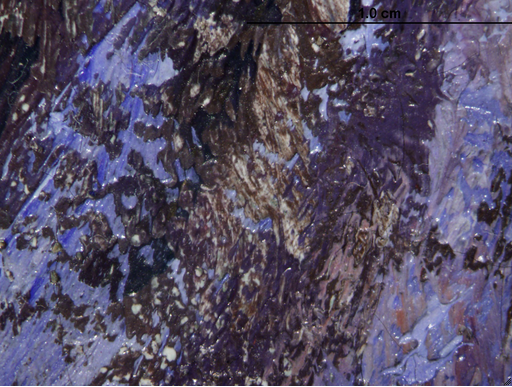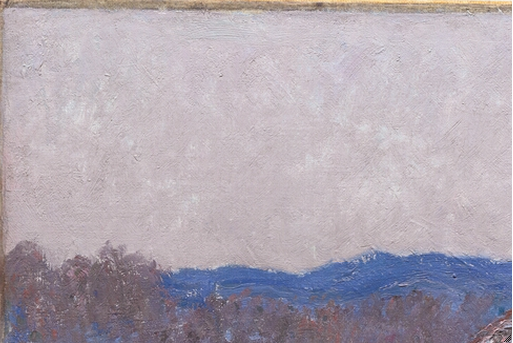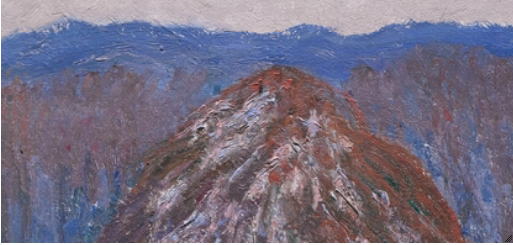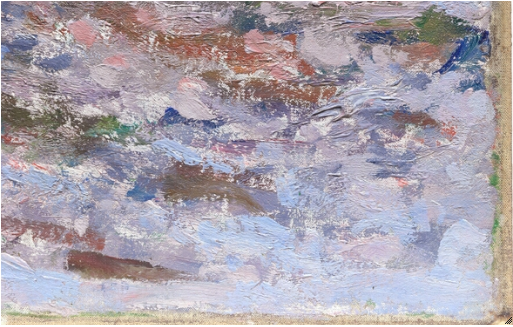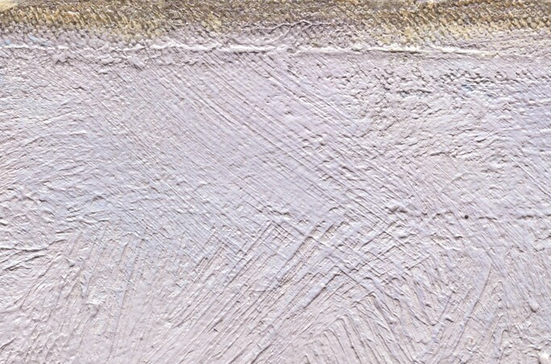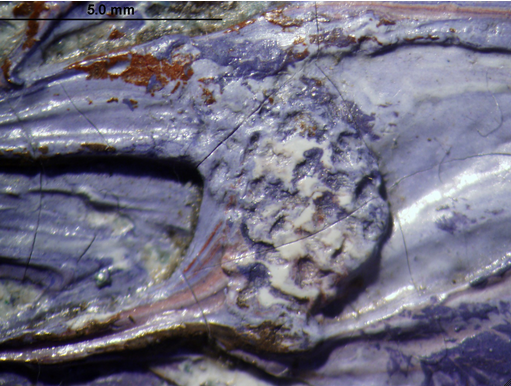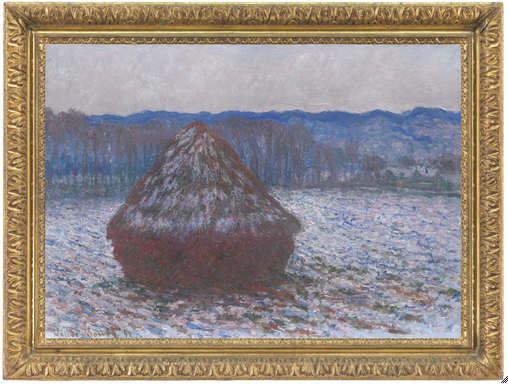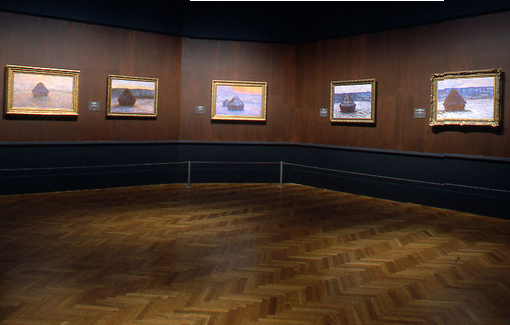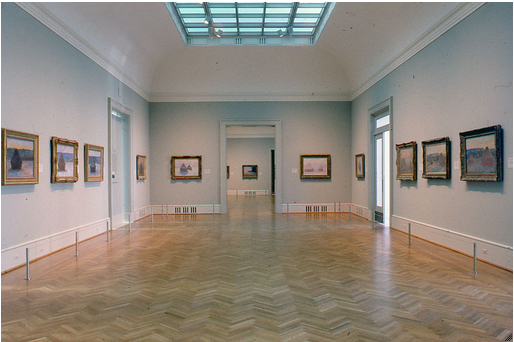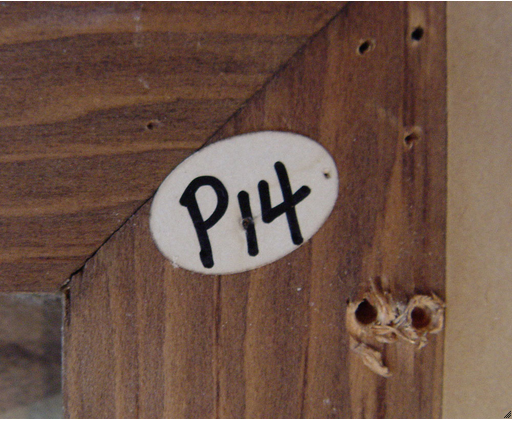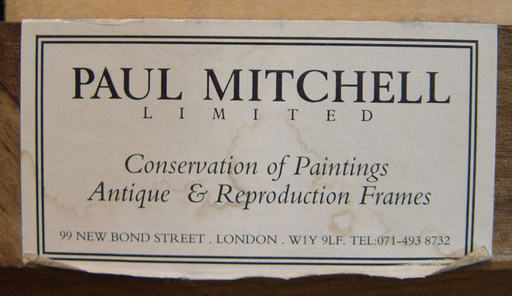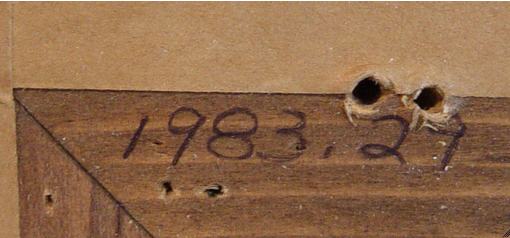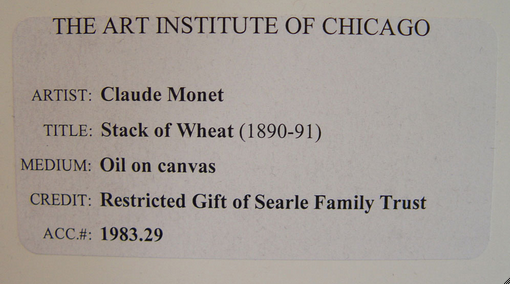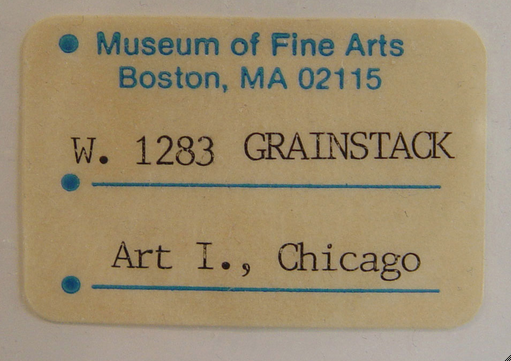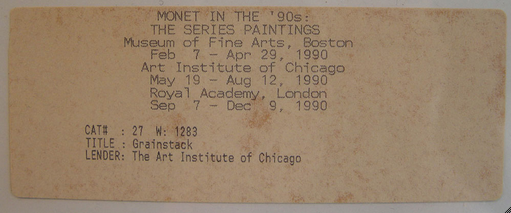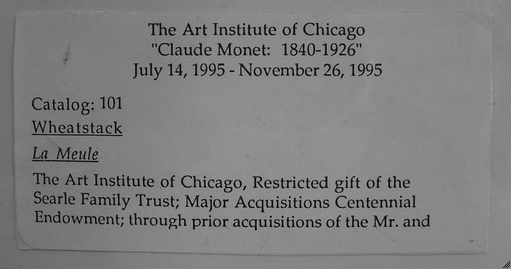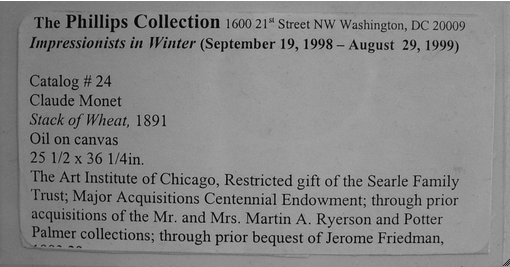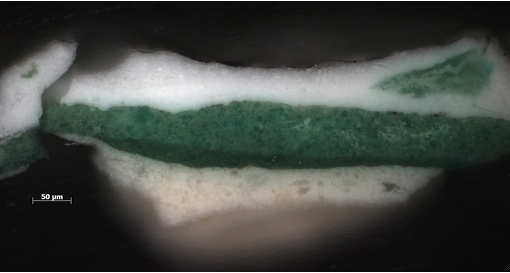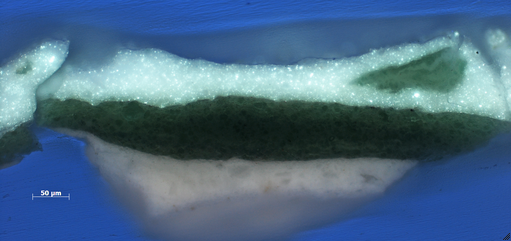Cat. 31
Stack of Wheat
1890/91
Oil on canvas; 65.8 × 92.3 cm (25 15/16 × 36 3/8 in.)
Signed and dated: Claude Monet 91 (lower left, in brownish paint)
The Art Institute of Chicago, restricted gift of the Searle Family Trust; Major Acquisitions Centennial Endowment; through prior acquisitions of the Mr. and Mrs. Martin A. Ryerson and Potter Palmer collections; through prior bequest of Jerome Friedman, 1983.29
Technical Report
Technical Summary
Claude Monet’s Stack of Wheat was painted on a pre-primed, no. 30 landscape (paysage) standard-size linen canvas. The ground consists of a single, off-white layer. The technical examination revealed that a different composition was started on the canvas. This was partially obliterated by a layer of white paint that was applied before the final composition was painted. It is difficult to tell precisely what the subject of the earlier composition was, but it seems to have included a prominent hill in the background on the left side. The stack does not appear to have been part of the earlier composition, based on the relatively dense buildup of the paint layers underneath the stack. Brushwork unrelated to the final composition is difficult to interpret due to interference from both the brushwork of the intermediate layer and the final painting. Breaks in the upper paint layers show that the earlier painting included bright green paint in areas underneath the field, the stack, and the hills, bright red paint in the foreground, and brighter shades of blue throughout the sky. This palette may indicate that the earlier composition was not a winter scene. The final painting consists largely of a wet-in-wet buildup of the brushwork. Final touches include the blue strokes dragged lightly over dry paint layers of the field and some finishing strokes applied at the lower corners. The stack appears to have been enlarged slightly on the left and right sides, with the brushstrokes at the edges extending over the field.
Multilayer Interactive Image Viewer
The multilayer interactive image viewer is designed to facilitate the viewer’s exploration and comparison of the technical images (fig. 31.1).
Signature
Signed and dated: Claude Monet 91 (lower left, in brownish paint) (fig. 31.2). Some of the underlying paint was dry when the painting was signed, but other areas, specifically the thick pale-blue strokes along the bottom edge were still wet. This pale-blue paint appears to be related to some finishing touches added at the lower left and lower right corners (fig. 31.3).
Structure and Technique
Support
Canvas
Linen (estimated).
Standard format
The original dimensions were approximately 65 × 92 cm. This corresponds to a no. 30 landscape (paysage) standard-size canvas.
Weave
Plain weave. Average thread count (standard deviation): 26.2V (0.8) × 20.5H (0.8) threads/cm. The vertical threads were determined to correspond to the warp and the horizontal threads to the weft. No weave or thread count matches were detected with other Monet paintings analyzed for this project.
Canvas characteristics
There is strong cusping along the left and top edges, moderate cusping along the right edge, and mild cusping on the bottom edge.
Stretching
Current stretching: The original canvas was mounted onto a one-sixteenth-inch solid metal support (the tacking margins were probably removed at this time); the metal support was then mounted onto a canvas and stretched onto the current stretcher before entering the Art Institute in 1983 (see Conservation History); tacks spaced 2–3 cm apart.
Original stretching: Unknown; original tacking edges removed in previous treatment (see Conservation History).
Stretcher/strainer
Current stretcher: Five-membered wood stretcher with vertical crossbar, and keyable, mitered mortise and tenon joints (six of ten keys inserted). Depth: 1.8 cm (outer edge).
Original stretcher: Discarded, not documented. Depth: Unknown.
Manufacturer’s/supplier’s marks
None observed in current examination or documented in previous examinations.
Preparatory Layers
Sizing
Not determined (probably glue).
Ground application/texture
Because the original tacking margins have been removed (see Conservation History), it is not possible to know whether the ground extended to the edges of all of the tacking margins. The ground does, however, appear to continue onto the tacking edges, parts of which are visible around the edges of the painting (fig. 31.4, fig. 31.5), thus suggesting that this was a pre-primed canvas. The ground consists of a single layer that ranges from approximately 10 to 80 µm in thickness (fig. 31.6).
Color
The ground is off-white, with dark particles visible under magnification (fig. 31.7).
Materials/composition
Analysis indicates the presence of the following components: lead white and calcium carbonate (chalk), with traces of iron oxide, alumina, various silicates, and silica. Binder: Oil (estimated).
Compositional Planning/Underdrawing/Painted Sketch
Extent/character
No underdrawing was observed with infrared reflectography (IRR) or microscopic examination.
Paint Layer
Application/technique and artist’s revisions
The painting has a rich textural surface that incorporates both wet-in-wet and wet-over-dry paint application, using a variety of brushwork. Technical imaging and close examination of the paint surface reveal the presence of brushwork and underlying layers of bright hues that are unrelated to the final composition. This is especially apparent at the edges of the painting where strokes of bright green and red paint are visible in the foreground area (fig. 31.8; fig. 31.9, fig. 31.10); in addition, shades of pale and bright blue can be seen in the sky (fig. 31.11; fig. 31.12). It appears that the artist used a broadly applied layer of white paint to cover the earlier, more colorful painting before beginning the final composition (fig. 31.13). This intermediate layer has a strong brushmarked surface that corresponds to the diagonal strokes (upper left to lower right) seen in the X-ray, especially in the sky and the stack areas (fig. 31.14). The white layer is visible at the edges of the painting (fig. 31.15) and at small areas of loss and breaks in the brushwork of the final composition (fig. 31.16, fig. 31.17, fig. 31.18). The white layer is not continuous but rather consists of open brushwork that often reveals glimpses of the underlying painting (fig. 31.19, fig. 31.20). Localized areas of interlayer cleavage between the earlier painting campaign and the intermediate white layer indicate that the earlier painting was already surface dry when it was painted over, resulting in poor adhesion between it and the layers applied on top (fig. 31.21). The relatively bright color scheme of the earlier painting may indicate that it was not a winter scene.
It is difficult to tell whether the earlier composition was also a wheat stack scene because the thick buildup of paint and the brushwork from the intermediate white layer make the X-ray difficult to read (fig. 31.22). However, there are brushstrokes unrelated to the final composition to the left of the stack, in the area of the trees. Toward the center of the painting, additional brushwork suggests a sloping landmass running through the upper center of the composition. The infrared reflectogram shows a form in the area above the trees on the left side (fig. 31.23). At breaks in the upper, pale pinkish-gray paint of the sky and the intermediate white layer in the area of this pentimento, dark and bright green paint is visible (fig. 31.24, fig. 31.25). Further areas of green paint were also observed at localized areas of abrasion along the horizon line (fig. 31.26), and down into the distant hills (fig. 31.27). The green paint of the earlier composition suggests that this was some kind of landform, which could relate to the sloping diagonal observed in the X-ray (i.e., a hill in the upper left third of the painting sloping down through the middle of the canvas to the midright edge).
The relative radio-opacity of the paint in the area of the stack suggests that the stack was not part of the original composition (fig. 31.28). The underlying paint layers were built up relatively densely underneath it; this includes bright green paint similar to that observed elsewhere in the foreground of the painting, which is visible microscopically through the open brushwork of the stack (fig. 31.29). The infrared reflectogram indicates that minor adjustments were made to the dimensions of the stack, particularly along the left and right edges where they were extended slightly over the field. Along the left edge of the stack, the intermediate white layer as well as some faint color strokes, is visible, suggesting that the snow-covered field was not worked up very far before the stack was expanded (fig. 31.30).
In the final composition, the paint application includes both wet-in-wet and wet-over-dry buildup of the layers. Through gaps in the upper paint layers, it appears that the stack was laid in with thinly applied strokes of dull reddish-brown and green-brown paint (fig. 31.31), and then built up with thicker, more textural strokes of deeper reds, purples, and greens. Lead white–rich strokes of pale blue and pale pink were used to indicate the snow-covered areas. The sky was built up wet-in-wet using undulating zigzag strokes in varying shades of gray with localized touches of pale blue, pink, and green added sporadically (fig. 31.32). The hills were reinforced along the upper edge, with long undulating strokes of blue paint, drawn along the horizon. These strokes pass over dry paint from the sky in some places, for example, near the center (fig. 31.33), with some final pinkish-gray strokes from the sky coming down over the hilltop, wet-in-wet. The dull purple trees were painted wet-in-wet over the sky and the hills in some places, and wet-over-dry in others. These observations indicate that the artist worked back and forth between the compositional elements to some extent. Some of the more fluid, thinly applied paint over the intermediate white layer (e.g., the dark blues and purples of the field and the hills and the dark browns, purples, and reds of the wheat stack) exhibits fine but extensive drying cracks, which appear to be caused by leaner, quicker-drying paint applied over slower-drying layers (fig. 31.34). Some of the final touches to the painting include the colorful strokes that were dragged across the peaks of the dried underlayers in the stack and the field, as well as finishing touches of pale-blue paint applied at the lower left and lower right corners, also over dry paint (fig. 31.35). The pale-blue paint was still wet when the painting was signed.
There are areas of disturbed paint in a narrow band approximately 1.5–2 cm from the top edge. It appears that something was pressed against the painting and then pulled away from the surface while the paint was still wet (fig. 31.36); this could relate to an easel cleat or transporting device. A few strokes of impasto, just above and to the right of the M in the signature, and in the lower right corner, are flattened and seem to have a canvas or board texture impressed into the surface (fig. 31.37, fig. 31.38). This could also be related to transport or stacking of paintings while the paint was still soft.
Painting tools
Brushes including 0.5 cm and 1.0 cm width, flat ferrule (based on width and shape of brushstrokes). There are several brush hairs embedded in the paint layer.
Palette
Analysis indicates the presence of the following pigments: lead white, zinc white, cadmium yellow, chrome yellow, iron oxide, vermilion, red lake, viridian, emerald green, cobalt blue, and ultramarine blue. UV fluorescence suggests the use of red lake throughout the landscape.
Binding media
Oil (estimated).
Surface Finish
Varnish layer/media
The painting was cleaned in 1997 and left unvarnished. The origin of the varnish layer that was removed is not known (see ). The painting has a relatively dry, matte surface in most areas, with some subtle variations in gloss depending on the qualities of the paint.
Conservation History
A receipt of object report in the conservation file indicates that the work was submitted to the Art Institute in 1943 for “cleaning and repair.” There is no documentation of what work was carried out.
Prior to acquisition, the painting was mounted onto a one-sixteenth-inch metal panel composed of zinc and copper, backed with a second canvas, and mounted on a five-membered wood stretcher. The tacking margins were probably removed at this time. A synthetic varnish was probably also applied at this time.
In 1997, the varnish was removed, and the painting was left unvarnished. Wax residues were removed mechanically. Minor inpainting was carried out.
Condition Summary
The painting is in good condition overall but suffers from past conservation treatment: the canvas has been mounted onto a one-sixteenth-inch solid-metal (zinc/copper) support; the metal support was then mounted onto a canvas and stretched onto the current stretcher. The original tacking margins were removed, probably at the time of this treatment. The painting does not appear to have been cut down in the process, as a border of unpainted ground is visible on all four sides. There is some flattening and moating of impasto, probably caused by the lining procedure. There are a few small losses in the upper paint layers, apparently the result of interlayer cleavage between the earlier painting campaign and the intermediate white layer applied before the final painting was executed. There is a general network of fine mechanical cracks, as well as localized areas of drying cracks throughout the painting. There is localized retouching in the sky and intermittently around the edges of the painting. The painting is currently unvarnished and has a generally matte appearance.
Kimberley Muir
Frame
Current frame (installed in 1995): The frame is not original to the painting. It is a reproduction of a Louis XIII convex frame with carved running acanthus leaves, plain hollow, and leaf-tip sight molding (Paul Mitchell Ltd., London 1995). The frame is water gilded over red bole on gesso. The hollow is burnished, while selective burnishing and a heavier rub were applied to the carved ornament. The frame is heavily toned with final washes of umber and gray with dark flecking. The carved jelutong molding is mitered and joined with angled dovetail splines. The molding from perimeter to interior, is cove side; convex face with carved running acanthus leaves; fillet with rocked recutting; hollow; fillet with rocked recutting; and ogee with carved leaf-tip sight (fig. 31.39).
Previous frame (installed by 1980; removed in 1995): The work was previously housed in a stylized, American, mid-twentieth-century frame based on a Louis XV reverse ogee profile (fig. 31.40).
Kirk Vuillemot
Provenance
Possibly sold by the artist to Isidore Montaignac, Paris, May 1899.
Acquired by Mrs. Potter (Bertha Honoré) Palmer, Chicago.
By descent from Mrs. Potter (Bertha Honoré) Palmer (died 1918), Chicago, to the Palmer family.
By descent in the Palmer family to Mrs. Arthur M. (Pauline Palmer) Wood, by Oct. 1951.
Acquired by Acquavella Galleries, New York, probably 1982.
Sold by Acquavella Galleries, New York, to the Art Institute of Chicago, 1983.
Exhibition History
Possibly Paris, Galeries Durand-Ruel, Exposition d’oeuvres récentes de Claude Monet, May 1891, cat. 11, as Meule. (Hiver.).
Los Angeles County Museum of Art, A Day in the Country: Impressionism and the French Landscape, June 28–Sept. 16, 1984, cat. 106 (ill.); Art Institute of Chicago, Oct. 23, 1984–Jan. 6, 1985; Paris, Galeries Nationales, Grand Palais, as L’impressionnisme et le paysage français, Feb. 4–Apr. 22, 1985.
Tokyo, Seibu Museum of Art, Shikago bijutsukan inshō-ha ten [The Impressionist tradition: Masterpieces from the Art Institute of Chicago], Oct. 18–Dec. 17, 1985, cat. 57 (ill.); Fukuoka Art Museum, Jan. 5–Feb. 2, 1986; Kyoto Municipal Museum of Art, Mar. 4–Apr. 13, 1986.
Boston, Museum of Fine Arts, Monet in the ’90s: The Series Paintings, Feb. 7–Apr. 29, 1990, cat. 27 (ill.); Art Institute of Chicago, May 19–Aug. 12, 1990; London, Royal Academy of Arts, Sept. 7–Dec. 9, 1990. (fig. 31.41)
Art Institute of Chicago, Chicago’s Dream, a World’s Treasure: The Art Institute of Chicago, 1893–1993, Nov. 1, 1993–Jan. 9, 1994, not in cat.
Art Institute of Chicago, Claude Monet, 1840–1926, July 22–Nov. 26, 1995, cat. 101 (ill.). (fig. 31.42)
Washington, D.C., Phillips Collection, Impressionists in Winter: Effets de neige, Sept. 19, 1998–Jan. 3, 1999, cat. 24 (ill.); Fine Arts Museums of San Francisco at the Center for the Arts at Yerba Buena Gardens, Jan. 30–May 2, 1999; New York, Brooklyn Museum of Art, May 28–Aug. 29, 1999.
Moscow, State Pushkin Museum of Fine Arts, Klod Mone [Claude Monet], Nov. 26, 2001–Feb. 21, 2002, cat. 30 (ill.); Saint Petersburg, State Hermitage Museum, May 1–15, 2002.
Fort Worth, Tex., Kimbell Museum of Art, The Impressionists: Master Paintings from the Art Institute of Chicago, June 29–November 2, 2008, cat. 79 (ill.).
Selected References
Possibly Galeries Durand-Ruel, Exposition d’oeuvres récentes de Claude Monet, exh. cat. (Galeries Durand-Ruel, 1891), p. 16, cat. 11.
Daniel Wildenstein, Claude Monet: Biographie et catalogue raisonné, vol. 3, Peintures, 1887–1898 (Bibliothèque des Arts, 1979), pp. 38; 142; 143, cat. 1283 (ill.)
Art Institute of Chicago, “Acquisitions,” Mosaic (July–Aug. 1983), p. 8 (ill.).
Art Institute of Chicago, A Record of Sharing with Chicago’s Masterpiece, annual report supplement (Art Institute of Chicago, [1983]), p. 14 (ill.).
Art Institute of Chicago, Art Institute of Chicago Annual Report 1982-83 (Art Institute of Chicago, 1983), pp. 5, fig. 5; 12.
Robert Gordon and Andrew Forge, Monet (Abrams, 1983), pp. 161 (ill.), 163, 292.
Andrea P. A. Belloli, ed., A Day in the Country: Impressionism and the French Landscape, exh. cat. (Los Angeles County Museum of Art, 1984), p. 364.
Richard R. Brettell, “The Fields of France,” in A Day in the Country: Impressionism and the French Landscape, ed. Andrea P. A. Belloli, exh. cat. (Los Angeles County Museum of Art, 1984), pp. 246; 260–262; 265, no. 106 (ill.).
Richard R. Brettell, “La champagne française,” in Réunion des Musées Nationaux, L’impressionnisme et le paysage français, exh. cat. (Réunion des Musées Nationaux, 1985), pp. 261; 278; 282–291, no. 106 (ill.).
Art Institute of Chicago, “A Day in the Country: Impressionism and the French Landscape,” Mosaic (Nov.–Dec. 1984), p. 3 (ill.).
Richard R. Brettell, “Monet’s Haystacks Reconsidered,” Art Institute of Chicago Museum Studies 11, 1 (Fall 1984), pp. 6; 7; 8, pl. 2; 12; 16–17, fig. 11 (ill.); 19; 21, n. 6, n. 17.
“French Paintings Recently Acquired by the Art Institute of Chicago,” Burlington Magazine 76, 976 (July 1984), p. 464, fig. 89.
Art Institute of Chicago, Seibu Museum of Art, Kyoto Municipal Museum of Art, and Fukuoka Art Museum, eds., Shikago bijutsukan inshō-ha ten [The Impressionist tradition: Masterpieces from the Art Institute of Chicago], trans. Akihiko Inoue, Hideo Namba, Heisaku Harada, and Yoko Maeda, exh. cat. (Nippon Television Network, 1985), pp. 116, cat. 57 (ill.); 117 (detail); 158 (ill.).
Richard R. Brettell, Post-Impressionists (Art Institute of Chicago, 1987), pp. 35, 39 (ill.), 118.
Richard Kendall, ed., Monet by Himself: Paintings, Drawings, Pastels, Letters, trans. Bridget Strevens Romer (Macdonald Orbis, 1989), pp. 202 (ill.); 320.
Paul Hayes Tucker, Monet in the ’90s: The Series Paintings, exh. cat. (Museum of Fine Arts, Boston/Yale University Press, 1989), pp. 3; 77; 82; 91, pl. 30; 296, cat. 27; back cover (ill.).
Anne Rorimer, “The Date Paintings of On Kawara,” Art Institute of Chicago Museum Studies 17, 2 (1991), p. 122, fig. 2.
John Sallis, “Monet’s Grainstacks: Shades of Time,” Tema Celeste International Art Magazine 30 (Mar.–Apr. 1991), pp. 60 (ill.); 63; 67, n.13.
Daniel Wildenstein, Claude Monet: Catalogue raisonné, vol. 5, Supplément aux peintures: Dessins; Pastels; Index (Wildenstein Institute, 1991), p. 47, cat. 1283.
Art Institute of Chicago, Treasures of 19th- and 20th-Century Painting: The Art Institute of Chicago, with an introduction by James N. Wood (Art Institute of Chicago/Abbeville, 1993), p. 117 (ill.).
William Mullen, “Art Institute Exhibit Hails Benefactors,” Chicago Tribune, Nov. 2, 1993, p. 6 (ill.).
Art Institute of Chicago, The Art Institute of Chicago: The Essential Guide, selected by James N. Wood and Teri J. Edelstein, entries by Sally Ruth May (Art Institute of Chicago, 1993), p. 164 (ill.).
John Andrew Fisher, Reflecting on Art (Mayfield, 1993), pp. 121, pl. 6; 200.
Denis Thomas, Monet on Location (Regency House, 1994), p. 52 (ill.).
Andrew Forge, Monet, Artists in Focus (Art Institute of Chicago, 1995), pp. 44; 91, pl. 20; 108.
Charles F. Stuckey, with the assistance of Sophia Shaw, Claude Monet, 1840–1926, exh. cat. (Art Institute of Chicago/Thames & Hudson, 1995), p. 122, cat. 101 (ill.).
Stephan Koja, Claude Monet, trans. John Brownjohn, exh. cat. (Österreichische Galerie, Belvedere, Vienna/Prestel, 1996), p. 31 (ill.).
Marietta S. Millet, Light Revealing Architecture (Van Nostrand Reinhold, 1996), p. 27, fig. 1–41c.
Daniel Wildenstein, Monet, or The Triumph of Impressionism, cat. rais., vol. 1 (Taschen/Wildenstein Institute, 1996), pp. 274–75, cat. 1283 (ill.); 275.
Daniel Wildenstein, Monet: Catalogue raisonné/Werkverzeichnis, vol. 3, Nos. 969–1595 (Taschen/Wildenstein Institute, 1996), pp. 495, cat. 1283 (ill.); 501.
Charles S. Moffett, “Effet de neige: ‘Claude Monet and a Few Others . . . ,’” in Charles S. Moffett, Eliza E. Rathbone, Katherine Rothkopf, and Joel Isaacson Impressionists in Winter: Effets de neige, exh. cat. (Phillips Collection/Philip Wilson, 1998), pp. 20, 22.
Charles S. Moffett, Eliza E. Rathbone, Katherine Rothkopf, and Joel Isaacson, Impressionists in Winter: Effets de neige, exh. cat. (Phillips Collection/Philip Wilson, 1998), pp. 79; 211, cat. 24.
Eliza E. Rathbone, “Road by Saint-Siméon Farm in Winter,” in Charles S. Moffett, Eliza E. Rathbone, Katherine Rothkopf, and Joel Isaacson, Impressionists in Winter: Effets de neige, exh. cat. (Phillips Collection/Philip Wilson, 1998), p. 82.
Katherine Rothkopf, “Rue Eugène Moussoir at Moret: Winter,” in Charles S. Moffett, Eliza E. Rathbone, Katherine Rothkopf, and Joel Isaacson, Impressionists in Winter: Effets de neige, exh. cat. (Phillips Collection/Philip Wilson, 1998), p. 188.
Katherine Rothkopf, “Stacks of Wheat (Snow Effect, Overcast Day); Stack of Wheat; Grainstacks: Snow Effect; Stacks of Wheat (Sunset, Snow Effect),” in Charles S. Moffett, Eliza E. Rathbone, Katherine Rothkopf, and Joel Isaacson, Impressionists in Winter: Effets de neige, exh. cat. (Phillips Collection/Philip Wilson, 1998), pp. 120; 122; 123, cat. 24 (ill.).
John Sallis, Shades—Of Painting at the Limit (Indiana University Press, 1998), pl. 7; p. 48.
Richard Shiff, “‘To move the eyes’: Impressionism, Symbolism and Well-Being, c. 1891,” in Impressions of French Modernity, ed. Richard Hobbs (Manchester University Press, 1998), pp. vii; 198, fig. 31.
Malcolm Andrews, Landscape and Western Art, Oxford History of Art (Oxford University Press, 1999), pp. 193, fig. 107; 234.
A. G. Kostenevich, Klod Mone [Claude Monet], exh. cat. (Khudozhnik i Kniga, 2001), pp. 82–83, cat. 30 (ill.).
Norio Shimada and Keiko Sakagami, Kurōdo Mone meigashū: Hikari to kaze no kiseki [Claude Monet: 1881–1926], vol. 2 (Nihon Bijutsu Kyōiku Sentā, 2001), pp. 70, no. 198 (ill.); 189.
Richard R. Brettell, From Monet to Van Gogh: A History of Impressionism, vol. 2 (Teaching Co., 2002), pp. 162, 167, 183.
Petra ten-Doesschate Chu, Nineteenth-Century European Art (Prentice-Hall/Abrams, 2003), pp. 408, fig. 17-11; 409.
Eleanor Dwight, ed., The Letters of Pauline Palmer: A Great Lady of Chicago’s First Family (M. T. Train/Scala, 2005), pp. 290 (ill.), 293, 326.
Anna Gruetzner Robins, “‘Slabs of Pink and Lumps of Brown’: The Critical Reaction to the Exhibition of a Monet Grainstack Painting in Britain in 1893,” in Monet and French Landscape: Vétheuil and Normandy, ed. Frances Fowle (National Galleries of Scotland, 2006), pp. 159; 168, n. 10.
Charles F. Stuckey, “The Predications and Implications of Monet’s Series,” in The Repeating Image: Multiples in French Painting from David to Matisse, ed. Eik Kahng, exh. cat. (Walters Art Museum/Yale University Press, 2007), pp. 85; 87–88, fig. 10.
Gloria Groom and Douglas Druick, with the assistance of Dorota Chudzicka and Jill Shaw, The Impressionists: Master Paintings from the Art Institute of Chicago, exh. cat. (Art Institute of Chicago/Kimbell Art Museum, 2008), pp. 11 (ill.); 21 (ill.); 22; 103; 108; 156; 159, cat. 79 (ill.). Simultaneously published as Gloria Groom and Douglas Druick, with the assistance of Dorota Chudzicka and Jill Shaw, The Age of Impressionism at the Art Institute of Chicago (Art Institute of Chicago/Yale University Press, 2008), pp. 11 (ill.); 21 (ill.); 22; 103; 108; 156; 159, cat. 79 (ill.).
John Updike, Always Looking: Essays on Art, ed. Christopher Carduff (Knopf, 2012), pp. 74-75 (ill.).
Other Documentation
Labels and Inscriptions
Undated
Sticker
Location: stretcher
Method: oval label with handwritten script
Content: P14 (fig. 31.43)
Post-1980
Label
Location: frame
Method: printed label
Content: PAUL MITCHELL / LIMITED / Conservation of Paintings / Antique & Reproduction Frames / 99 NEW BOND STREET. LONDON. W1Y 9LF. TEL:071-493 8732 (fig. 31.44)
Number
Location: frame
Method: handwritten script
Content: 1983.29 (fig. 31.45)
Label
Location: stretcher
Method: printed label with typewritten script and green-ink inventory stamp
Content: THE ART INSTITUTE OF CHICAGO / CHICAGO ILLINOIS 60603, U.S.A. / To MONET, Claude (French) / La Meule (Haystack) 1891 / 1983.29
Stamp: Inventory [. . .] 1984 (fig. 31.46)
Label
Location: backing board
Method: printed label
Content: THE ART INSTITUTE OF CHICAGO / ARTIST: Claude Monet / TITLE: Stack of Wheat (1890–91) / MEDIUM: Oil on canvas / CREDIT: Restricted Gift of Searle Family Trust / ACC.#: 1983.29 (fig. 31.47)
Label
Location: (previous?) frame; transcription in conservation file
Method: not documented
Content: The Minneapolis Institute of Arts / No. L82.224 / Lent / by / Acquavella / Gallery (fig. 31.48)
Label
Location: backing board
Method: printed label with typewritten script
Content: Museum of Fine Arts / Boston, MA 02115 / W. 1283 GRAINSTACK / Art I., Chicago (fig. 31.49)
Label
Location: backing board
Method: printed label
Content: MONET IN THE ’90s: / THE SERIES PAINTINGS / Museum of Fine Arts, Boston / Feb 7–Apr 29, 1990 / Art Institute of Chicago / May 19–Aug 12, 1990 / Royal Academy, London / Sep 7–Dec 9, 1990 / CAT# : 27 W: 1283 / TITLE : Grainstack / LENDER: The Art Institute of Chicago (fig. 31.50)
Label
Location: backing board
Method: printed label
Content: The Art Institute of Chicago / “Claude Monet: 1840–1926” / July 14, 1995–November 26, 1995 / Catalog: 101 / Wheatstack / La Meule / The Art Institute of Chicago, Restricted gift of the / Searle Family Trust; Major Acquisitions Centennial / Endowment; through prior acquisitions of the Mr. and [sic] (fig. 31.51)
Label
Location: backing board
Method: printed label
Content: The Phillips Collection 1600 21st Street NW Washington, DC 20009 / Impressionists in Winter (September 19, 1998–August 29, 1999) / Catalog # 24 / Claude Monet / Stack of Wheat, 1891 / Oil on canvas / 25 1/2 x 36 1/4in. / The Art Institute of Chicago, Restricted gift of the Searle Family / Trust; Major Acquisitions Centennial Endowment; through prior / acquisitions of the Mr. and Mrs. Martin A. Ryerson and Potter / Palmer collections; through prior bequest of Jerome Friedman, / [cut off but probably 1983.29] (fig. 31.52)
Examination and Analysis Techniques
X-radiography
Westinghouse X-ray unit, scanned on Epson Expressions 10000XL flatbed scanner. Scans digitally composited by Robert G. Erdmann, University of Arizona.
Infrared Reflectography
Goodrich/Sensors Unlimited SU640SDV-1.7RT with H filter (1.1–1.4 µm) and J filter (1.5–1.7 µm); Inframetrics Infracam with 1.5–1.73 µm filter; Fujifilm S5 Pro with X-Nite 1000B/2 mm filter (1.0–1.1 µm).
Visible Light
Natural-light and raking-light overalls and macrophotography: Fujifilm S5 Pro with X-NiteCC1 filter.
Ultraviolet
Fujifilm S5 Pro with X-NiteCC1 filter and Kodak Wratten 2E filter.
High-Resolution Visible Light (and Ultraviolet)
Sinar P3 camera with Sinarback eVolution 75 H (PECA 918 UV/IR interference cut filter and Kodak Wratten 2E filter).
Microscopy and Photomicrographs
Sample and cross-sectional analysis using a Zeiss Axioplan 2 research microscope equipped with reflected light/UV fluorescence and a Zeiss AxioCam MRc5 digital camera. Types of illumination used: darkfield, differential interference contrast (DIC), and UV. In situ photomicrographs with a Wild Heerbrugg M7A StereoZoom microscope fitted with an Olympus DP71 microscope digital camera
X-ray Fluorescence Spectroscopy (XRF)
Several spots on the painting were analyzed in situ with a Bruker/Keymaster TRACeR III-V with rhodium tube.
Polarized Light Microscopy (PLM)
Zeiss Universal research microscope.
Scanning Electron Microscopy/Energy-Dispersive X-ray Spectroscopy (SEM/EDX)
Cross sections analyzed after carbon coating with a Hitachi S-3400N-II VP-SEM with an Oxford EDS and a Hitachi solid-state BSE detector. Analysis was performed at the Northwestern University Atomic and Nanoscale Characterization Experimental (NUANCE) Center, Electron Probe Instrumentation Center (EPIC) facility.
Automated Thread Counting
Thread count and weave information were determined by Thread Count Automation Project software.
Image Registration Software
Overlay images registered using a novel image-based algorithm developed by Damon M. Conover (GW), John K. Delaney (GW, NGA), and Murray H. Loew (GW) of the George Washington University’s School of Engineering and Applied Science and the National Gallery of Art, Washington, D.C.
Image Inventory
The image inventory compiles records of all known images of the artwork on file in the Conservation Department, the Imaging Department, and the Department of Medieval to Modern European Painting and Sculpture at the Art Institute of Chicago (fig. 31.53).

